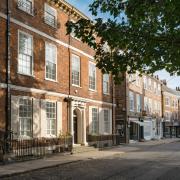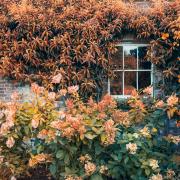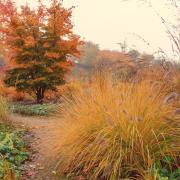June is upon us, and we are into the tennis season in a big way. We’re lucky enough to have world class tennis on our doorstep. The Lexus Ilkley Trophy starts this month and then … Wimbledon. It made me think about the elements of grass court tennis that we love so much. The beautifully clipped green sward of lawn, bowls of luscious strawberries and those gorgeous planters of white, green, and purple flowers used to identify the championship surroundings in the British LTA colours.
Lawns are not now only for suburbanites; or the cricket, tennis, and bowling fraternity, out on a Sunday morning with their lawn mowers and edging shears. Lawns have been recognised as critical habitats and food sources for many insects and pollinators. ‘No mow May’ is an initiative to get gardeners to leave their lawns to grow, and allow clover, self-heal, and dandelions to flower their socks off and support the emerging insect life. I’ve adopted this for the past few years and have seen other wildflowers pop up to take advantage of my ‘laziness’ such as cardamine and one bee orchid! Last autumn I planted pheasant eye narcissus, snakes head fritillaries and camassia bulbs in the lawn. These all tolerate growing through the grass and flower from March through to June. I planted these varieties because they naturally grow in water meadows and with our wetter winters, I’m finding these are happier than other narcissus. To show the ‘neglect’ is intentional, I mow a couple of paths through the area, avoiding the emerging bulbs to encourage my visitors to wander through. Not only does this help the wildlife but makes it look like it’s a deliberate garden feature. I then mow at the end of June to allow the bulbs to die down naturally for next year. I’ve seen a great increase in biodiversity including cinnabar moths, yellow brimstone butterflies, grasshoppers and crickets coming into my garden. What could be a better reason than that?

Garden to visit.
York Gate garden at Adel is a beautiful Arts and Crafts garden tucked away at the top of the suburbs of Leeds and offering a great opportunity to find gardening tricks that you can use in your own gardens. From decorative chequered paths to the unusual wall trained conifers, there’s something to inspire everyone. The glasshouse is my favourite part of the garden with their stunning collection of succulents grown in aged terracotta pots, but the long borders around the plant centre are also bursting with planting ideas use at home. Well worth a visit this June.

Plant of the Month.
June is the month for roses and our white Yorkshire rose typifies our love of these flowers. Introduced to Europe in the 12th century, the British immediately took the scented blooms to our hearts. There are now roses for every area of the garden, patio roses for pots, climbing roses for north walls, roses for dry sandy soils... The trick is to do your homework and find the right rose for the right spot. Nothing says summer like a pergola drowning in a scented cascade from an established rambling rose. Planted with a viticella clematis extends the colour right into Autumn.

Why have my strawberries stop flowering?
A very timely question with the upcoming tennis season, so thank you for asking. Strawberries are a crop that you must refurbish every three years, not repurchase but to propagate runners from the parent plants. Luckily strawberries oblige us by sending out stems with baby strawberry plants on them for you to root. When you see the runners being thrown out, wait until the embryo plants develop on the end and then using a bent wire hoop, fill some 9cm pots with compost and anchor the young plant onto the pot of compost. The plant will root and after a couple of months you can cut the baby plant from the parent plant. You then discard a third of the parent plants and replant the new ones in their place in the autumn. Use some bone meal to get the new plants to root well in the bed and next year they will reward you with lots of fruit. From then on discard a third of the older crop every autumn and repeat the process.
I spend a lot of time in the spring getting my garden looking good but then it all stops flowering from June onwards. Can you give me some late flowering suggestions for my courtyard garden which is unfortunately mainly in shade.
I’m asked a lot about shade loving plants, but this is a bit more focussed. You are talking about the horticultural phenomenon called the ‘June gap’. Roses fade and late flowering plants are still building up. In a courtyard garden you have an advantage as you can move containers around. Rotate the spent pots to the back to continue to build up for next year. My go to shade loving plants for summer and autumn include Hydrangea paniculata ‘little lime’, Buddleia Buzz series, rose Madame Hardy, rose the Fairy and for climbing E F Lester. For later perennials I would recommend Penstemon Huskers red and Japanese anemones such as Honorine Jobert. All need deadheading to keep the fresh flowers coming and a high potash feed. This selection should give you lasting colour right into autumn.



























